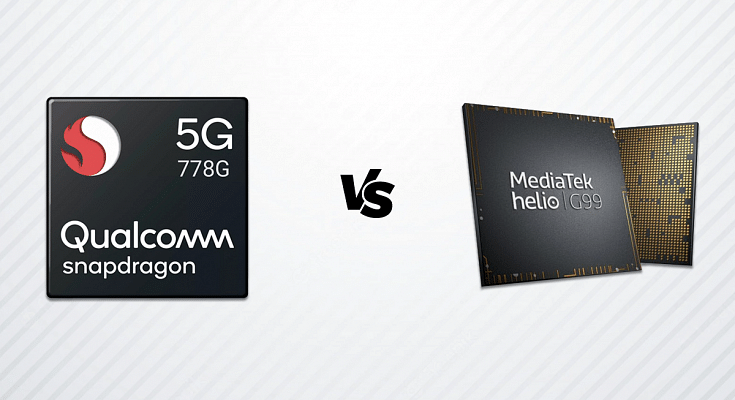Qualcomm and MediaTek are the driving force behind Android smartphones across the global markets. All major smartphone OEMs opt for either a Qualcomm or MediaTek series chipset to power their products. We have been comparing the latest mobile chipsets from both these brands. This article is a quick comparison between the Snapdragon 778G processor and the Helio G99 processor. How do both the chipsets compare in terms of CPU and GPU performance? Read on here:
Qualcomm Snapdragon 778G Vs MediaTek Helio G99: CPU Performance
Both Qualcomm Snapdragon 778G processor and the Helio G96 chipset are built on a 6nm fabrication process. The Qualcomm mid-range processor has octa-cores including one 2.4GHz Cortex-A78 core, three Cortex-A78 cores clocked at 2.2GHz, and four Cortex-A55 cores at 1.9GHz. The MediaTek Helio G99 also has octa-cores which there are two Cortex-A75 cores clocked at 2.2GHz and six Cortex-A55 cores clocked at 2GHz. The frequency range for Qualcomm Snapdragon 778G is 2400 MHz, while the Helio chipset has a 2200MHz frequency range.
Snapdragon 778G Vs Helio G99: GPU Comparison
The Qualcomm Snapdragon 778G processor has the Adreno 642L GPU which is built on Adreno 600 architecture. On the contrary, the Helio G99 comes with Mali-G57 MC2 GPU support which is based on Valhall architecture with each of them offering 2 execution units. The SD 778G has 384 shading units, while the Helio G99 has only 32 shading units. Both chipsets have a 1.1 Vulkan version, 2.0 OpenCL Version, and 12 DirectX version.
Snapdragon 778G Vs Helio G99: Memory, Multimedia (ISP) Comparison
Moving on to the memory type, the octa-core Snapdragon 778G processor comes with LPDDR5 RAM with a max memory frequency and bandwidth of 3200 MHz and 25.5 Gbit/s respectively. The maximum memory size is 16GB with the Qualcomm chipset. Moving on to the Helio G99, it has LPDDR4X RAM support with 4266MHz memory frequency and 10GB max memory size. Qualcomm has added support for UFS 2.1, UFS 2.2, UFS 3.0, ad UFS 3.1 storage, whereas MediaTek has added support for just UFS 2.2 storage.
As for the Multimedia, the max display and camera resolution supported by the Qualcomm Snapdragon 778G processor are 2520 x 1080 pixels and 1x192MP/ 2x36MP respectively. The MediaTek Helio G99 processor offers the same max display resolution but slightly different max camera resolution, i.e., 1x108MP and 2x 16MP. The video recording and playback capability is 4K@30fps with the Snapdragon 778G chipset and 2K@30fps with the MediaTek Helio G99 processor.
